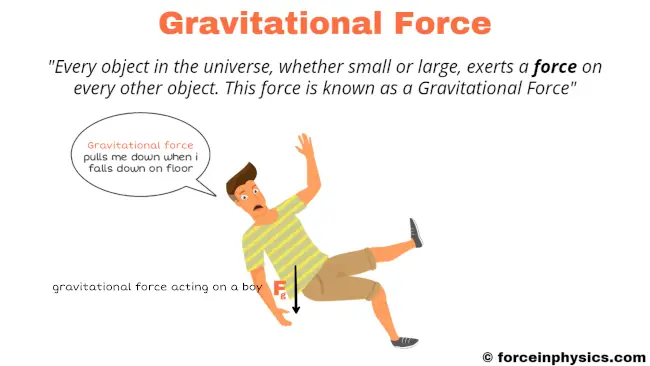
Gravity is a fundamental force in nature that causes objects with mass to be attracted to one another. It is the reason why when an individual jumps or falls, they are pulled back to the ground. This force is present everywhere in the universe and plays a crucial role in shaping celestial bodies and governing their movements. For instance, gravity keeps planets in stable orbits around stars. The strength of gravity depends on the mass of the objects involved, where larger masses result in a more significant gravitational pull. This force, universal in nature, is a cornerstone of physics. It governs the behavior of all objects possessing mass and offers profound insights into the interactions between matter on a cosmic scale.
Examples
Apple
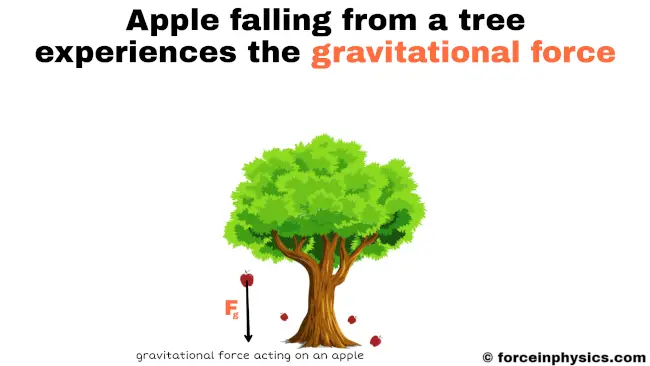
The way a ripe apple plummets from a tree is a perfect example of gravity’s effect in action. As envisioned by Sir Isaac Newton, gravity exerts an attractive force on objects with mass, such as the apple, and causes them to be drawn towards the center of the Earth. As a result, the apple detaches from the tree and gracefully descends to the ground. This fundamental force of nature governs the motion of the apple, ensuring it experiences a downward pull and finds its way to the Earth’s surface.
Tap water
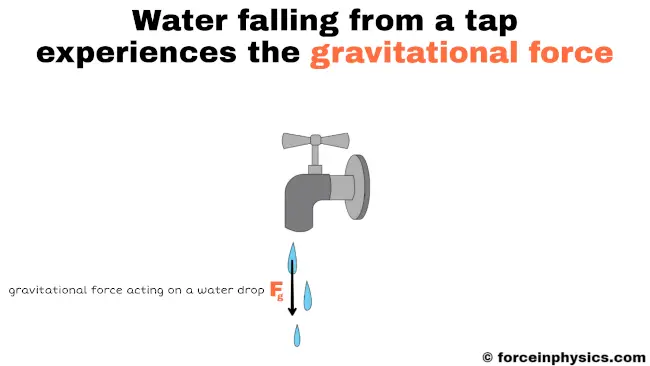
When a tap is opened, water flows out and descends to the ground. This downward motion of tap water occurs because of the force of gravity. Sir Isaac Newton’s theory of gravity explains how this fundamental force attracts objects with mass towards the center of the Earth. Consequently, gravity pulls the water downward, causing it to flow out of the tap and fall to the ground. This straightforward yet significant example demonstrates how gravity influences the behavior of everyday objects, like tap water, ensuring they are drawn towards the Earth’s surface.
Dropped ball
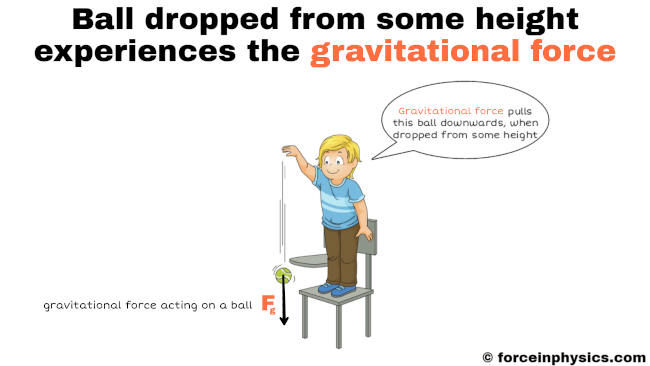
The concept of gravity becomes evident when observing a dropped ball. As the ball is released from a certain height, it is drawn downwards by the force of gravity. This universal force acts on all objects with mass, causing them to fall towards the Earth. Regardless of the ball’s weight or the height from which it is dropped, gravity ensures a consistent and predictable downward motion and guides the ball toward the ground.
Waterfall
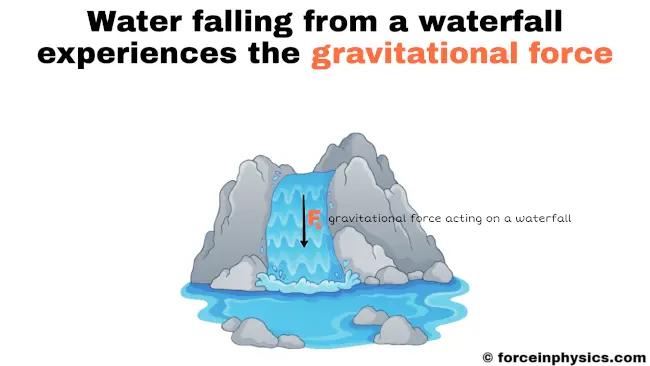
A waterfall provides a tangible example of gravity’s influence. As water descends over a cliff, gravity pulls it downward, accelerating its movement. The height of the waterfall dictates the potential energy of the water prior to its descent. As the water gains speed, it also gains kinetic energy. Upon reaching the base, the water may collide with rocks or gather in a pool, illustrating how gravity determines its trajectory. Waterfalls thus exemplify how gravity shapes the movement of objects on Earth, such as the flow of water.
Slipped coin
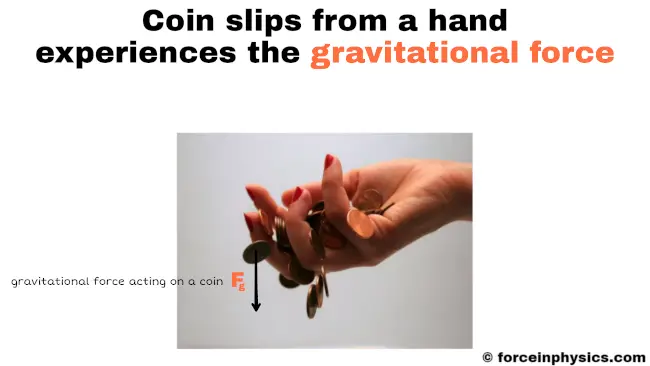
When holding a handful of coins and gently loosening the grip, some coins slip and fall downward. This phenomenon occurs due to the force of gravity, a natural force that pulls objects towards the Earth’s surface. Gravity causes the coins to be drawn downward, regardless of their number or the height from which they fall. This consistent gravitational pull guides the coins’ descent and illustrates the fundamental nature of gravity in everyday experiences.
Swimming
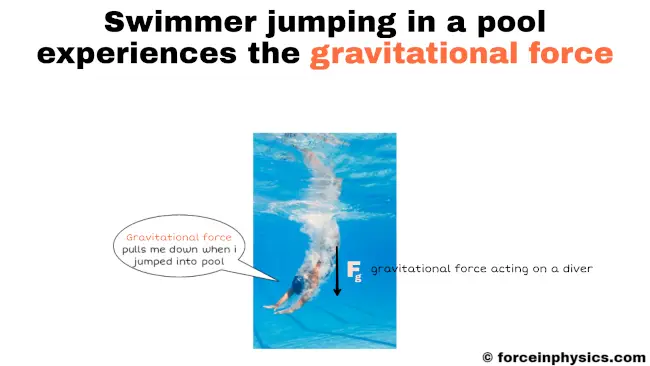
When swimmers enter a swimming pool, gravity immediately starts pulling them downward, while the water exerts an opposite force called buoyancy, pushing them upwards. This dynamic balance between gravity and buoyancy determines whether swimmers will float, sink, or remain suspended at a certain depth. When the upward buoyant force exceeds gravity, swimmers float effortlessly on the water’s surface. Conversely, if gravity overpowers the buoyant force, they will sink. This delicate interplay between gravity and buoyancy influences how objects, such as swimmers, behave in swimming pools.
Tennis ball
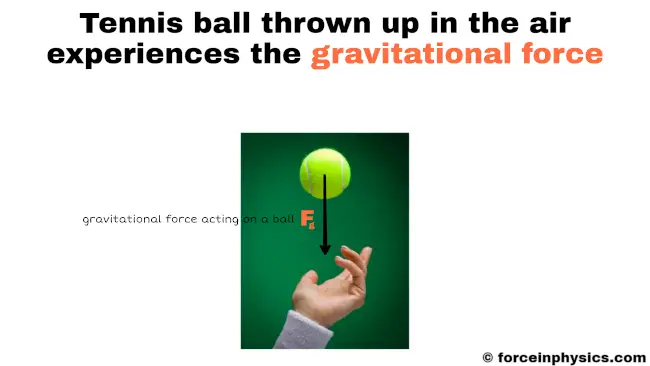
When a tennis ball is thrown into the air, it gracefully descends back down towards the ground, illustrating the force of gravity in action. Regardless of the height from which it is launched, the ball consistently moves towards the Earth, pulled by gravitational force. This behavior exemplifies the universal nature of gravity, as all objects with mass experience this downward pull.
Flying kite
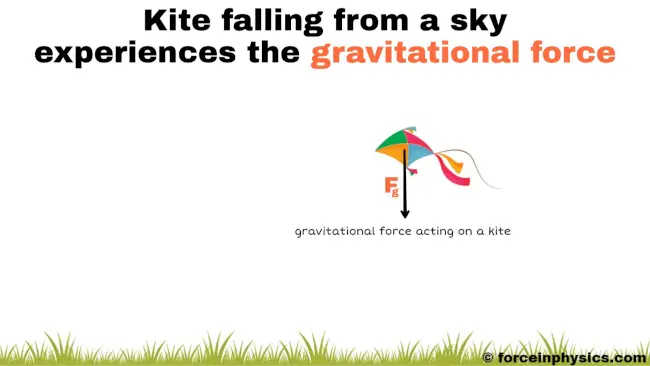
When flying a kite during the festival of Makar Sankranti, if the thread gets cut or becomes detached, the kite descends gracefully to the ground. This observable event provides a clear illustration of the force of gravity in action, as it pulls the kite downwards once it loses the upward tension from the thread.
Equation
The gravity equation, g = GM/r2, describes the relationship between the acceleration due to gravity (g), the universal gravitational constant (G), the mass of the celestial body (M), and the distance between the centers of mass (r). This equation allows for the calculation of gravitational acceleration between two objects, taking into account their masses and the distance separating them.
Practice problems
Problem #1
Calculate the acceleration due to gravity on star B’s surface, knowing that its mass is 1.5 × 1025 kg, and its radius is 20 × 103 km. Consider the universal gravitational constant as G = 6.67 × 10-11 Nm2/kg2.
Solution
Given data:
- Acceleration due to gravity on star B’s surface, g = ?
- Mass of the star B, M = 1.5 × 1025 kg
- Radius of the star B, r = 20 × 103 km = 20 × 106 m
- Universal gravitational constant, G = 6.67 × 10-11 Nm2/kg2
Using the equation:
- g = GM/r2
- g = (6.67 × 10-11 × 1.5 × 1025)/(20 × 106)2
- g = (10.005 × 1014)/(400 × 1012)
- g = 0.0250125 × 102
- g = 2.50 m/s2
Therefore, the acceleration due to gravity on star B’s surface is 2.50 m/s2.
Problem #2
Find the gravitational acceleration on the surface of comet A, with the comet’s mass being 9.875 × 1022 kg and its radius measuring 2.15 × 103 km. The universal gravitational constant is G = 6.67 × 10-11 Nm2/kg2.
Solution
Given data:
- Gravitational acceleration on the surface of comet A, g = ?
- Mass of the comet A, M = 9.875 × 1022 kg
- Radius of the comet A, r = 2.15 × 103 km = 2.15 × 106 m
- Universal gravitational constant, G = 6.67 × 10-11 Nm2/kg2
Using the equation:
- g = GM/r2
- g = (6.67 × 10-11 × 9.875 × 1022)/(2.15 × 106)2
- g = (65.8662 × 1011)/(4.6225 × 1012)
- g = 14.24 × 10-1
- g = 1.42 m/s2
Therefore, the gravitational acceleration on the surface of comet A is 1.42 m/s2.
Problem #3
Determine the gravitational acceleration at the surface of dwarf planet Z, knowing that it has a mass of 4.8 × 1023 kg and a radius of 3 × 103 km. Take the value of the universal gravitational constant as G = 6.67 × 10-11 Nm2/kg2.
Solution
Given data:
- Gravitational acceleration at the surface of dwarf planet Z, g = ?
- Mass of the dwarf planet Z, M = 4.8 × 1023 kg
- Radius of the dwarf planet Z, r = 3 × 103 km = 3 × 106 m
- Universal gravitational constant, G = 6.67 × 10-11 Nm2/kg2
Using the equation:
- g = GM/r2
- g = (6.67 × 10-11 × 4.8 × 1023)/(3 × 106)2
- g = (32.016 × 1012)/(9 × 1012)
- g = 3.55 m/s2
Therefore, the gravitational acceleration at the surface of dwarf planet Z is 3.55 m/s2.
Problem #4
Find the gravitational acceleration at the surface of celestial body A, given that its mass is 4.8 × 1024 kg, and its radius is 6.789 × 103 km. The universal gravitational constant is G = 6.67 × 10-11 Nm2/kg2.
Solution
Given data:
- Gravitational acceleration at the surface of the celestial body, g = ?
- Mass of the celestial body, M = 4.8 × 1024 kg
- Radius of the celestial body, r = 6.789 × 103 km = 6.789 × 106 m
- Universal gravitational constant, G = 6.67 × 10-11 Nm2/kg2
Using the equation:
- g = GM/r2
- g = (6.67 × 10-11 × 4.8 × 1024)/(6.789 × 106)2
- g = (32.016 × 1013)/(46.0905 × 1012)
- g = 0.6946 × 10
- g = 6.94 m/s2
Therefore, the gravitational acceleration at the surface of the celestial body is 6.94 m/s2.
Related
- Balanced force
- Unbalanced force
- Friction
- Tension (physics)
- Applied force
- Normal force
- Drag (physics)
- Gravity
- Centripetal force
- Centrifugal force
- Buoyancy
- Net force
- Compression (physics)
More topics
External links
- Gravity – Wikipedia
- What Is Gravity? – NASA Space Place (.gov)
- Gravity | Definition, Physics, & Facts – Britannica
- What is gravity? – Space.com
- How does gravity work? – HowStuffWorks
- Gravity Definition & Meaning – Merriam-Webster
- Gravity Definition & Meaning – Dictionary.com
- What is gravity? – Live Science
- Gravity – Stanford University
- What is gravity? – Qualitative Reasoning Group
- What is gravity? – New Scientist
- Gravity: The Universe’s Main Attraction – American Museum of Natural History
- Gravity: The Elements of Geodesy – National Oceanic and Atmospheric Administration (.gov)
- What is gravity? – Cool Cosmos
- Explainer: What is gravity? – Cosmos Magazine
- What is gravity or how does gravity work? – Union University
- Gravity – Physics for Kids – Ducksters
- What is gravity? – European Space Agency
- What is gravity (or gravitation)? – TechTarget
- Motion: Gravity – Physics4Kids
- gravity – Wiktionary
- Gravity – TheSchoolRun
- Gravity – Definition, Meaning & Synonyms – Vocabulary.com
- GRAVITY – Cambridge Dictionary
- Gravity Concepts and Applications – HyperPhysics Concepts
- Gravity – Maths Is Fun
Deep
Forceinphysics.com was founded by Deep Rana, who is a mechanical engineer by profession and a blogger by passion. He has a good conceptual knowledge on different educational topics and he provides the same on this website. He loves to learn something new everyday and believes that the best utilization of free time is developing a new skill.
